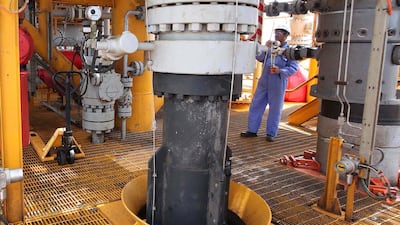Oman crude oil trading on the Dubai Mercantile Exchange last month slumped for the fourth month in succession, extending the bearish trend that started in the summer. Prices hit fresh four-year lows mid-October, before finding some support during the latter part of the month.
DME Oman crude for December delivery settled at US$83.58 per barrel (bbl) on October 31, down 90 cents/bbl on the day and a fall of $12.31/bbl over the month, or 13 per cent – the largest monthly fall since May 2012, when prices tumbled by more than $14/bbl.
Oman oil prices have now fallen 25 per cent from the June high of $111.18/bbl, which coincided with the ISIL march across northern Iraq and prompted concerns that the country's oil infrastructure could be under threat.
The monthly average price of the DME, which is used by Oman and Dubai to set their official selling price (OSP) was $86.96/bbl, down $10.30 from an average of $97.26/bbl for the November contract traded in September, and the lowest OSP since November 2010, when the average was $83.40/bbl.
The 25 per cent slide in oil prices since early summer has raised discussion that Opec may need to curb output, but the indications so far suggest Opec members have made almost no effort to curb production.
A Reuters survey concluded that Opec’s output in October dipped by just 120,000 barrels per day, with the downtick led by Angola and Nigeria. Overall Opec production was still hovering 720,000 bpd above its 30 million bpd target, said the survey.
Opec will meet on November 27 in Vienna. Early signals suggest there will be no meaningful production cuts; "I don't think 2015 will be far away from 2014 in terms of production," Opec's secretary general, Abdalla Salem El -Badri, said late last month. This has led some analysts to conclude that a lack of will among key producers to scale back production – particularly Saudi Arabia – is to manage a price retreat now and stem the onset of shale oil until the world is ready to absorb significant new volumes of oil and gas, which could trigger a price crash at a later date. Shale oil, often referred to as "tight oil", has much higher production costs than conventional oil produced in the Middle East.
Further downwards pressure came with the strengthening dollar, which rose to its highest level since 2010 after data showed the US economy grew 3.5 per cent in the third quarter. A stronger dollar makes commodities priced in the currency, including oil, costlier for buyers using other denominations.
Goldman Sachs cut its price forecast for North Sea Brent and US West Texas Intermediate (WTI) crude by $15/bbl a barrel for the first quarter of next year because rising production in non-Opec countries outside North America is expected to outstrip demand.
The US investment bank slashed its forecast for a barrel of WTI to $75 from $90, and for a barrel of Brent to $85 from $100.
The Brent/Oman spread has been around $2, so the implied Goldman Sachs forecast for Oman crude in 2015 is $83/bbl.
The Middle East physical crude oil market last month was dominated by an unusually large buying spree by China Oil, the trading subsidiary of China National Petroleum Corporation. China Oil bought 47 spot cargoes of December-loading crude oil – or 23.5 million barrels.
Industry analysts said that most of the oil would eventually be used for the parent company’s refining system, but that amount of spot oil could not be consumed in a single month so January buying requirements may fall.
China Oil’s buying spree also included 23 cargoes of Adnoc’s Upper Zakum crude, which was a record number of cargoes traded in the spot market.
Paul Young is the head of energy products, DME
Follow The National's Business section on Twitter

